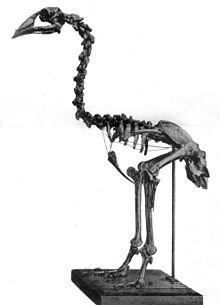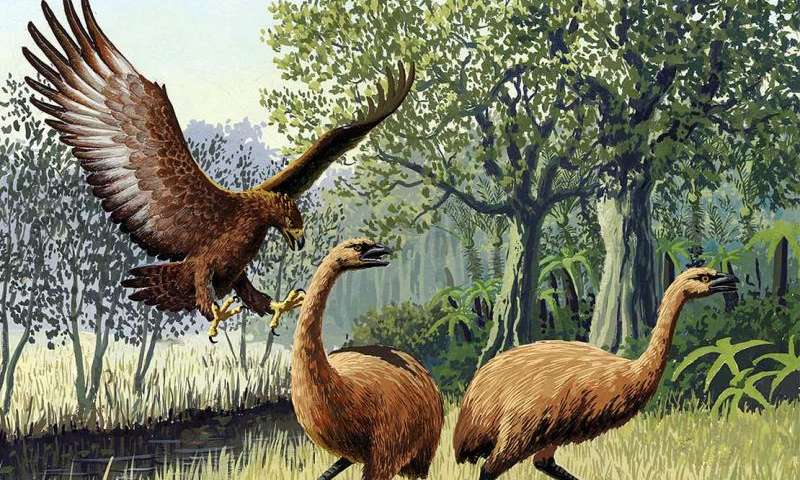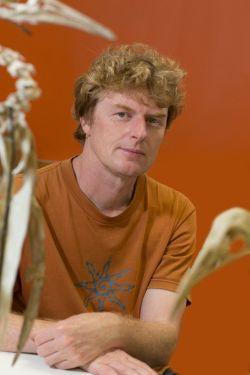
Adzebill skeleton
The extinction of a species is a heartbreaking thought, especially when you consider that some of our most beloved species, like monarch butterflies, frogs and toads, and bats are threatened, by disease or climate change, to the point that they may not be around for our grandchildren to see. Someday, they may only exist in museums, as remote to humans as moa and adzebills.
Say what now? Yes, moa and adzebills existed once, but the flightless birds have been extinct for thousands of years. You may never have heard of them (I certainly hadn’t) but a collaboration between scientists at Massey University, the Auckland War Memorial Museum and the Museum of New Zealand Te Papa Tongarewa is bringing them back to life. Okay, not literally bringing them back to life – stop your Jurassic Park fantasies – but thanks to 3D scanning, the birds, along with several other of New Zealand’s extinct bird species, are being made more real than they have been for a long time.

Artist’s rendition of an extinct Haast’s Eagle, left, hunting moa. [Credit: John Megahan, Creative Commons licence]
“We are going to see more of this in New Zealand,” said Dr. Thomas. “For a while now, researchers have used CT scanners to make digital versions of 3D bones, but few museums have this technology in-house. The 3D scanner we have is portable, so it can be brought into museum collections.”
The birds whose bones will be scanned this week include the adzebill, the Haast’s Eagle, and the Forbes Harrier. Right now they’re just names to most laypeople, but their digital models will make their features, like the adzebill’s weaponized beak or the harrier’s long legs, memorable. The scanning project is part of a growing trend in museums and research institutions to scan, digitally model and print bones and fossils so that they can be more closely studied and easily shared with the public.
“Technology like 3D printing is the way of the future, and will help to ensure precious objects, like bones from long extinct birds, are protected while still being fully accessible to the public,” said Alan Tennyson, vertebrate curator at the Museum of New Zealand.
Since the collaboration also involves sharing and exchanging exhibits, fossils at Auckland Museum will be scanned later this year and sent to the Museum of New Zealand. It’s amazing to think about, really, that something as rare as an ancient fossil can be so easily copied in perfect detail. It’s also amazing to think that long-dead species can be reconstructed. Below, you can play with a little bush moa – I bet that’s never something you imagined yourself doing, is it? Discuss this story in the 3D Printing Extinct Birds forum on 3DPB.com.
Subscribe to Our Email Newsletter
Stay up-to-date on all the latest news from the 3D printing industry and receive information and offers from third party vendors.
You May Also Like
Gorilla Sports GE’s First 3D Printed Titanium Cast
How do you help a gorilla with a broken arm? Sounds like the start of a bad joke a zookeeper might tell, but it’s an actual dilemma recently faced by...
Nylon 3D Printed Parts Made More Functional with Coatings & Colors
Parts 3D printed from polyamide (PA, Nylon) 12 using powder bed fusion (PBF) are a mainstay in the additive manufacturing (AM) industry. While post-finishing processes have improved the porosity of...
$25M to Back Sintavia’s Largest Expansion of Metal 3D Printing Capacity Since 2019
Sintavia, the digital manufacturing company specializing in mission-critical parts for strategic sectors, announced a $25 million investment to increase its production capacity, the largest expansion to its operations since 2019....
Velo3D Initiates Public Offering in a Bid to Strengthen Financial Foundations and Drive Future Growth
Velo3D (NYSE: VLD) has been among a number of publicly traded 3D printing firms that have attempted to weather the current macroeconomic climate. After posting a challenging financial report for 2023,...
































